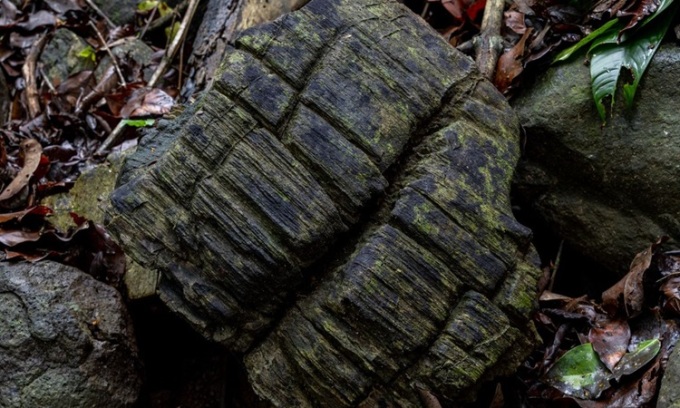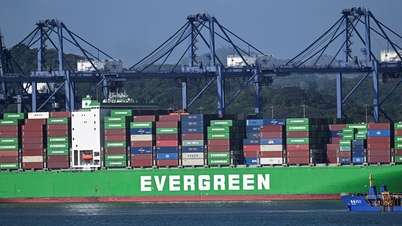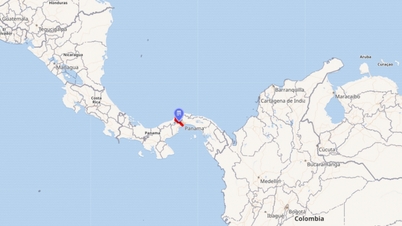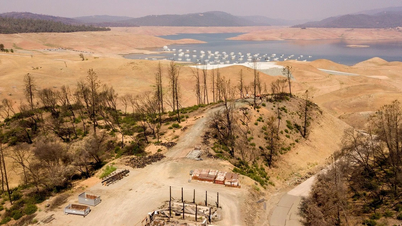Fossils discovered on Barro Colorado Island reveal that Panama once had a giant mangrove forest with trees 25-40 m high, buried by volcanic mud 23 million years ago.

A fossilized wood specimen on Barro Colorado Island. Photo: Christian Ziegler
An ancient mangrove forest with trees up to 40 meters tall was discovered more than 20 million years after volcanic mudflows covered the area in what is now Panama, according to research published in the journal Palaeogeography, Palaeoclimatology, Palaeoecology . Researchers first found the fossils in 2018 during a geological expedition to Barro Colorado Island (BCI). The island is located in Panama's artificial Gatun Lake, where thousands of ships pass each year when transiting the Panama Canal.
BCI was once located in a hilly area that was partially flooded in 1913, when engineers dammed the Chagres River to create a canal, and became a nature reserve in 1923. Today, the rainforests at BCI are among the most studied in the world .
“We never imagined that there would be a fossil forest at BCI, and despite countless scientists having surveyed the island over the past decade, no one had ever mentioned it,” said study co-author Carlos Jaramillo, a geologist at the Smithsonian Tropical Research Institute in Panama. “The fossils are difficult to distinguish from decaying trees in the forest because they look like rotten logs.”
Despite their appearance, the mangrove fossils are remarkably well preserved, according to Jaramillo. That’s because a volcanic eruption buried the tree trunks about 23 million years ago in the early Miocene (5.3 million to 23 million years ago), slowing decomposition and preserving the forest over time.
“Petrified wood, or petrified wood, contains a wealth of information,” said study leader Camila Martínez Aguillón, a paleoecologist at EAFIT University in Colombia. The cell structures, mineralized over geological periods and preserved intact, provide researchers with a rare window into the past.
The team examined 121 fossilized wood specimens found in a small inlet on the island and found that 50 belonged to a previously unknown species, called Sonneratioxylon barrocoloradoensis . The newly discovered fossil tree is similar to the mangrove tree found in Southeast Asia, Australia, New Zealand and some surrounding islands, and parts of Africa.
While the canopy of most living mangroves reaches 13 m, S. barrocoloradoensis grows to 25-40 m. The ancient tree likely evolved similar survival strategies to modern mangroves, preferring brackish water to highly saline seawater. The forest grew on the edge of the narrow peninsula connecting central Panama to North America before the Isthmus of Panama formed, some 3-23 million years ago.
An Khang (According to Live Science )
Source link




![[Photo] President of the Cuban National Assembly visits President Ho Chi Minh's Mausoleum](https://vphoto.vietnam.vn/thumb/1200x675/vietnam/resource/IMAGE/2025/10/1/39f1142310fc4dae9e3de4fcc9ac2ed0)

![[Photo] Hanoi morning of October 1: Prolonged flooding, people wade to work](https://vphoto.vietnam.vn/thumb/1200x675/vietnam/resource/IMAGE/2025/10/1/189be28938e3493fa26b2938efa2059e)
![[Photo] Keep your warehouse safe in all situations](https://vphoto.vietnam.vn/thumb/1200x675/vietnam/resource/IMAGE/2025/10/1/3eb4eceafe68497989865e7faa4e4d0e)















![[INFOGRAPHIC] DJI Osmo Nano Action camera, super compact, 4K 120fps recording](https://vphoto.vietnam.vn/thumb/402x226/vietnam/resource/IMAGE/2025/10/1/8408489112ee446dab897373255c827e)











































































Comment (0)